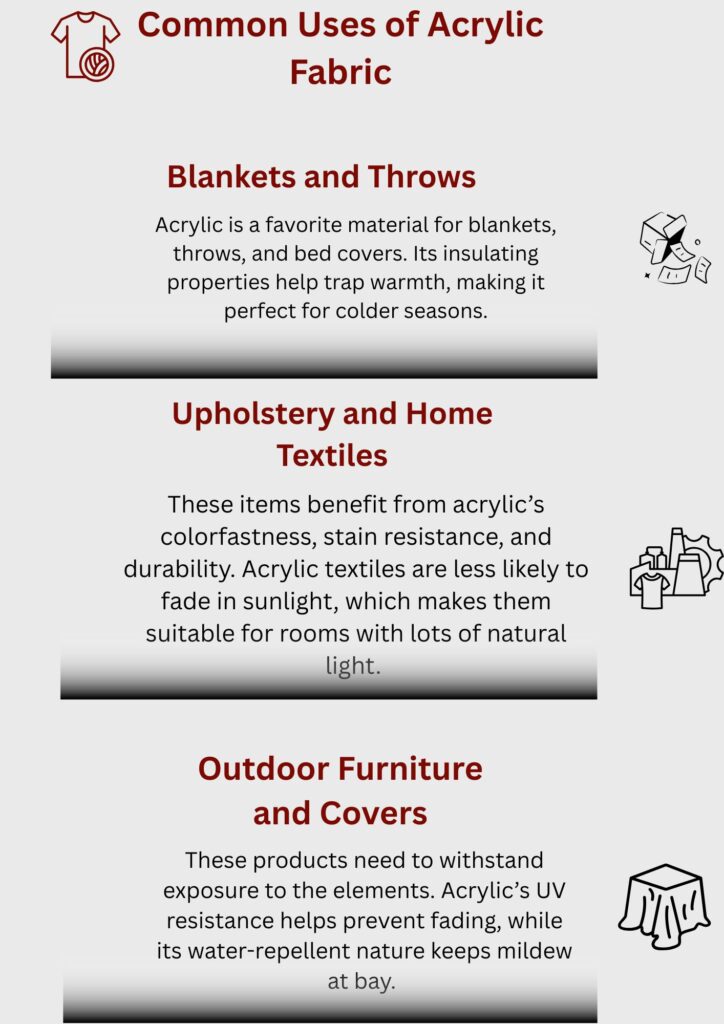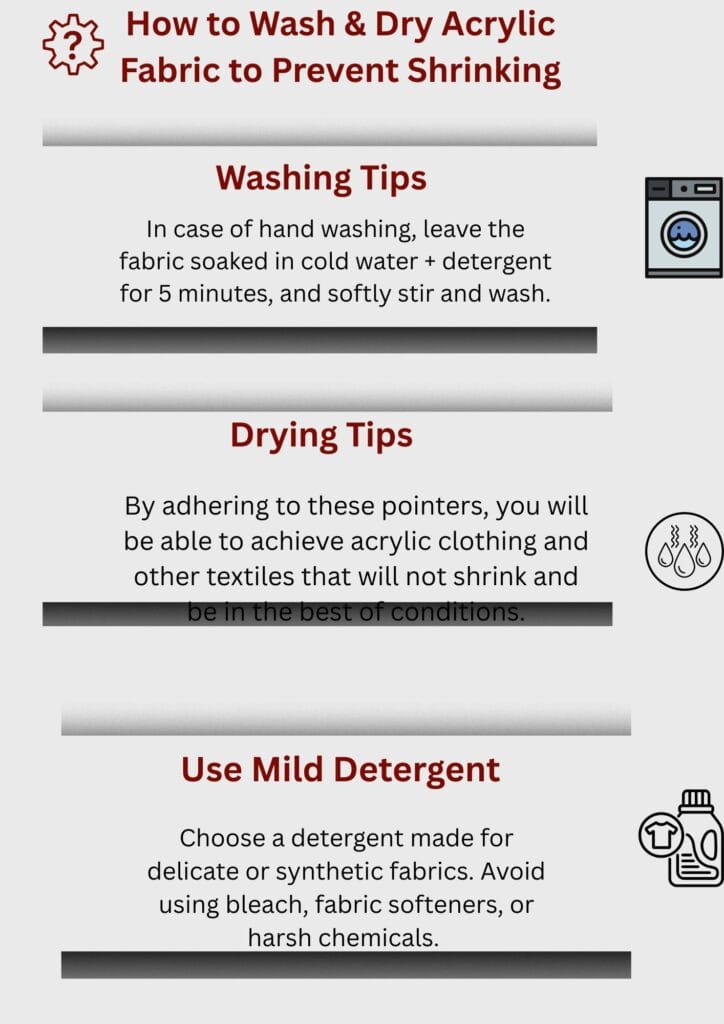Introduction
Acrylic is the man made fiber made out of a polymer known as acrylonitrile. This is usually used in replacement of wool since it is light, warm and soft. The material is famous because of its capacity to resemble the feel of natural materials and possessing certain benefits when it comes to durability and care.does acrylic fabric shrink
What is Acrylic Fabric?
It is soft, insulating and lightweight, in addition to being wool-Like. Acrylic does not get effected by moths, sunlight and mildew unlike natural fibers like cotton or wool.
Its structure makes it breathable and moisture-wicking, which is ideal for both cold and warm weather. It holds dye well, which means it retains color after many washes.
Common Uses of Acrylic Fabric

Acrylic finds a lot of application in products. You will usually see it in:
- Scarves and sweaters
- Gloves and hats
- Drapery and furnishing
- Furniture of outdoors denudates
- Throws and blankets
It is an all-purpose item and therefore a favorite both in terms of style and usability. Acrylic outdoor products have a longer life span as this material cannot fade and get wet.
The Reason People Select Acrylic
It is cheap when used in comparison with natural fiber such as wool or silk. It is also long-lasting and unable to wear out quickly, lose color, and stretch.
Moreover, acrylic fabrics are mothproof, that is why it is a good option to pack anything and keep it long-term. It is also convenient and good to look at since it is easy to take care of and has a soft touch.
Does acrylic fabric shrink? (Direct Answer)
The brief reply to the question does acrylic fabric shrink? is no, in most cases. Acrylic material is naturally shrink proof. But in some circumstances, it is able to alter shape or size.
Why Acrylic does not Shrink
Acrylic is not like the natural fibers in that it is prepared using thermoplastic material. This implies that the fibers are actually placed under warm temperatures in the process of manufacturing. Consequently, they are difficult to react to the forces shrinking cotton or wool.
The fabrics made of acrylics do not absorb a lot of water thus retaining their shape when they are wet. They are wrinkle and shrink resistant thanks to their synthetic composition and therefore they are suitable to be used on a daily basis.
Scientific Explanation
The fibers also have cross-linked polymers that make them be able to keep their former shape. Thus, acrylic clothes do not shrink or decimate unless exposed to boiling temperatures.
What Can Lead to Acrylic Shrinking?
Although acrylic is generally shrink-proof, there are some aspects that may make it change in size or shape. Being aware of them, it is possible to avoid accidental distortion during laundry.
Extreme Heat
One of the biggest threats to acrylic fabric is heat. Exposure to high temperatures, especially during washing or drying, may soften the fibers. This softening can cause them to distort or compress, which appears as shrinkage.
Boiling water, hot dryers, or ironing on high settings can affect the structure.
Wrong Washing and Drying Methods
Deformation is one of them, e.g. by washing in hot water, or the use of too harsh detergents. In the same respect, tumble-drying in high temperatures might damage the fiber structure, particularly with repeat washing.
Even aggressive spin cycles may cause stretching or misshaping. That’s why gentle handling is essential.
Blended Fabrics
In case these natural fibers are shrink-prone, the whole fabric can be erratic. To take an example, a sweater containing 50 percent cotton and 50 percent acrylic can shrink because of the percentage of cotton content – even though that portion of acrylic is not shrinking.
Always ensure you look at the label of the type of fabric so as to decide on how to wash it.
How to Wash & Dry Acrylic Fabric to Prevent Shrinking
The best solution to avoid shrinking of acrylic fabric is taking care of it. In order to give your garments and home textiles longevity, use the following tips.

Washing Tips
- Cold or Lukewarm Water: Hot water must be avoided since it may destroy the fibers.
- Gentle Cycle or Hand Wash: Less friction and strain is caused on the fabric.
- Mild Detergents: Do not use bleach or a harsh chemical. Use mild color-safe products.
In case of hand washing, leave the fabric soaked in cold water + detergent for 5 minutes, and softly stir and wash.
Drying Tips
- Air-Dry Flat or Hang Dry: The least risky way is to place things flat and dry. Hanging is also effective provided that it is not in direct sunlight.
- When a Dryer is used: Low heat or no heat setting. Take out as soon as possible to prevent being over-dried.
- Ironing Acrylic: In case ironing is required, the iron must be set at a very low temperature and then a thin cloth should be put between the iron and the piece of clothing so as to avoid direct contact between the cloth and the iron.
By adhering to these pointers, you will be able to achieve acrylic clothing and other textiles that will not shrink and be in the best of conditions.
Can You Un-Shrink Acrylic Fabric?
There are instances where shrinkage occurs no matter how hard you strive to prevent it. What can you do, then?
Limber Stretches As You are Wet
If the shrinkage is minor, you can try stretching the item gently while it’s still damp. Lay the garment flat on a towel and tug it lightly into shape. Let it air dry in this position.
Steam Treatment
Steam may help relax the fibers slightly. Use a steamer or steam setting on your iron while keeping a cloth barrier between the heat and fabric. Stretch gently as you go.
Limitations
Acrylic does not play out as naturally occurring fibers do. In case shrinkage is considerable, it will not recover fully. The synthetic fibres just do not possess the elasticity to stretch back completely like plastic does.
Acrylic vs. Comparison of Shrinkage with Other Fabrics
Understanding the comparison of acrylic with other materials assists you in comprehending its advantages better.
Cotton
Cotton is a natural fiber and is very likely to loss its size mostly during hot waters or drying in high temperatures. Cotton may even shrink even in pre-shrunken cotton after repeated washings.
Wool
Felting is a process that makes wool be easily shrunken. The fibers lock together as a consequence of moisture, heat, and agitation making an obvious difference in the size of wool garments.
Polyester
Polyester, like acrylic, is a synthetic fiber. It shares similar heat-resistant qualities and has minimal shrinkage when cared for properly.
Blended Fabrics
Blends behave randomly. A cotton-acrylic mix, such as provided as an example, will tend to shrink as compared to 100 percent acrylic. Never carry out the instructions of care, which are specific to the dominating fiber.
Common Myths About Acrylic Shrinking
There are a number of myths under the acrylic fabric and its reaction to washing. Let us wipe the confusion.
It reads, all Synthetic Fabrics never shrink.
This is not entirely so. Although synthetic fibers such as acrylics have a better resistance to shrinking compared to those of natural fiber, they nevertheless can shrink due to high temperatures or during harsh handling.
“Acrylic Behaves Like Wool”
Acrylic may look and feel like wool, but it behaves very differently. Wool shrinks from moisture and agitation; acrylic does not unless exposed to heat. It mimics wool in texture—not in maintenance.
Conclusion
So, does acrylic fabric shrink? Generally, no. When cared for properly, acrylic remains stable and true to size. However, exposing it to high heat or combining it with shrink-prone fibers can lead to trouble. To keep your acrylic clothes and furnishings in great shape, wash in cold water, dry flat, and avoid harsh conditions. With these smart care tips, you can enjoy the durability and softness of acrylic for years to come.


